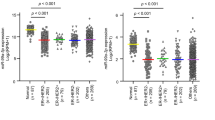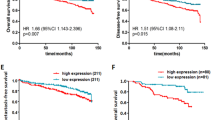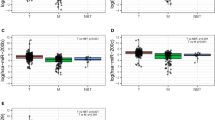Abstract
This study aimed to identify microRNAs (miRs), the deregulated expression of which leads to the activation of oncogenic pathways in human breast cancer (BC). miRs are classes of endogenous, small, noncoding RNAs that regulate gene expression aberrantly in human tumor tissues. A total of 39 out of 123 tumoral and matched uninvolved peritumoral breast specimens from 3 independent subsets of patients were analyzed for the expression of 851 human miRs using an Agilent platform. The remaining 84 samples were used to validate miRs differentially expressed between tumoral and matched peritumoral specimens by quantitative polymerase chain reaction. Animal assay was further used to test the role of miR-9 and Her-2 in the pathogenesis of BC. All 39 matched samples were analyzed by unsupervised cluster analysis. This analytical approach identified a signature of miRs (miR-9, miR-148a, miR-31, miR-375, miR-21, miR-135b, miR-196a and miR-196b) that were significantly modulated between tumoral and peritumoral tissues in both subsets of patients. Her-2 protein staining increased in tumoral specimens when miR-9 downregulation correlated with the prognostic value. The ectopic expression of miR-9 inhibited the colony-forming ability, migration and tumor engraftment of BC cells. miR-9 targeted the Her-2 messenger RNA and increased responsiveness of BC cells to docetaxel (DOC) or cyclophosphamide treatment. The ectopic expression of Her-2 protein counteracted the miR-9 proapoptotic activity in response to DOC. These findings suggested that the modulation of aberrant expression of miR-9, which in turn induces oncogenic Her-2 protein activity, might hold promise for preventive and therapeutic management of BC.
This is a preview of subscription content, access via your institution
Access options
Subscribe to this journal
Receive 12 print issues and online access
$259.00 per year
only $21.58 per issue
Buy this article
- Purchase on Springer Link
- Instant access to full article PDF
Prices may be subject to local taxes which are calculated during checkout





Similar content being viewed by others
References
Farazi TA, Spitzer JI, Morozov P, Tuschl T . miRNAs in human cancer. J Pathol 2011; 223: 102–115.
Madhu B, Dadulescu M, Griffiths J . Artefacts in (1)H NMR-based metabolomic studies on cell cultures. MAGMA 2015; 28: 161–171.
Sandhu R, Rivenbark AG, Mackler RM, Livasy CA, Coleman WB . Dysregulation of microRNA expression drives aberrant DNA hypermethylation in basal-like breast cancer. Int J Oncol 2014; 44: 563–572.
Zhou Y, Feng X, Liu YL, Ye Si-C, Wang H, Tan W-K et al. Down-regulation of miR-126 is associated with colorectal cancer cells proliferation, migration and invasion by targeting IRS-1 via the AKT and ERK1/2 signaling pathways. PLoS ONE 2013; 8: e81203.
Le Quesne J, Caldas C . Micro-RNAs and breast cancer. Mol Oncol 2010; 4: 230–241.
Selcuklu SD, Donoghue MT, Rehmet K, de Souza Gomes M, Fort A, Kovvuru P et al. MicroRNA-9 inhibition of cell proliferation and identification of novel miR-9 targets by transcriptome profiling in breast cancer cells. J Biol Chem 2012; 287: 29516–29528.
Meiyanto E, Putri DDP, Susidarti RA, Murwanti R, Sardjiman, Fitriasari A et al. Curcumin and its analogues (PGV-0 and PGV-1) enhance sensitivity of resistant MCF-7 cells to doxorubicin through 20 inhibition of HER2 and NF-kB activation. Asian Pac J Cancer Prev 2014; 15: 179–184.
Minami T, Kijima T, Otani Y, Kohmo S, Takahashi R, Nagatomo I et al. HER2 as therapeutic target for overcoming ATP-binding cassette transporter-mediated chemoresistance in small cell lung cancer. Mol Cancer Ther 2012; 11: 830–841.
Zhang R, Li Y, Dong X, Peng L, Nie X . MiR-363 sensitizes cisplatin-induced apoptosis targeting in Mcl-1 in breast cancer. Med Oncol 2014; 31: 347.
Chen L, Bourguignon LY . Hyaluronan-CD44 interaction promotes c-Jun signaling and miRNA21 expression leading to Bcl-2 expression and chemoresistance in breast cancer cells. Mol Cancer 2014; 13: 52.
Deng X, Cao M, Zhang J, Hu K, Yin Z, Zhou Z et al. Hyaluronic acid-chitosan nanoparticles for co-delivery of MiR-34a and doxorubicin in therapy against triple negative breast cancer. Biomaterials 2014; 35: 4333–4344.
Yang G, Wu D, Zhu J, Jiang O, Shi Q, Tian J et al. Upregulation of miR-195 increases the sensitivity of breast cancer cells to adriamycin treatment through inhibition of Raf-1. Oncol Rep 2013; 30: 877–889.
Korner C, Keklikoglou I, Bender C, Wörner A, Münstermann E, Wiemann S . MicroRNA-31 sensitizes human breast cells to apoptosis by direct targeting of protein kinase C epsilon (PKCepsilon). J Biol Chem 2013; 288: 8750–8761.
Cittelly DM, Das PM, Salvo VA, Fonseca JP, Burow ME, Jones FE . Oncogenic HER2{Delta}16 suppresses miR-15a/16 and deregulates BCL-2 to promote endocrine resistance of breast tumors. Carcinogenesis 2010; 31: 2049–2057. 21.
Zhou M, Liu Z, Zhao Y, Ding Y, Liu H, Xi Y et al. MicroRNA-125b confers the resistance of breast cancer cells to paclitaxel through suppression of pro-apoptotic Bcl-2 antagonist killer 1 (Bak1) expression. J Biol Chem 2010; 285: 21496–21507.
Viedma-Rodríguez R, Baiza-Gutman L, Salamanca-Gómez F, Diaz-Zaragoza M, Martínez-Hernández G, Ruiz Esparza-Garrido R et al. Mechanisms associated with resistance to tamoxifen in estrogen receptor-positive breast cancer (Review). Oncol Rep 2014; 32: 3–15.
Yang C, He L, He P, Liu Y, Wang W, He Y et al. Increased drug resistance in breast cancer by tumor-associated macrophages through IL-10/STAT3/bcl-2 signaling pathway. Med Oncol 2015; 32: 352.
Zhou Y, Ouyang T, Wang T, Xie Y, Fan Z, Fan T et al. The study of associations between circulating tumor cells and clinicopathologic characteristics in axillary lymph node positive primary breast cancer. Zhonghua wai Ke Za Zhi 2014; 52: 420–424.
Raica M, Cimpean AM, Ceauşu RA, Fulga V, Nica C, Rudico L et al. Hormone receptors and HER2 Expression in primary breast carcinoma and corresponding lymph node metastasis: do we need both? Anticancer Res 2014; 34: 1435–1440.
Zhou X, Marian C, Makambi KH, Kosti O, Kallakury BV, Loffredo CA et al. MicroRNA-9 as potential biomarker for breast cancer local recurrence and tumor estrogen receptor status. PLoS ONE 2012; 7: e39011.
Zheng H, Zhang L, Zhao Y, Yang D, Song F, Wen Y et al. Plasma miRNAs as diagnostic and prognostic biomarkers for ovarian cancer. PLoS One 2013; 8: e77853.
Katarina C, Manuela Z, Dharanija M, Sarah S, Michael G, Jörg H et al. Plasma microRNA panel for minimally 22 invasive detection of breast cancer. PLoS ONE 2013; 8: e76729.
Ono S, Oyama T, Lam S, Chong K, Foshag LJ, Hoon DS . A direct plasma assay of circulating microRNA-210 of hypoxia can identify early systemic metastasis recurrence in melanoma patients. Oncotarget 2015; 6: 7053–7064.
Acknowledgements
This study was funded by a grant from the key scientific and technological project for Jilin Province of China (grant number 20150204081SF).
Author contributions
SL carried out the molecular genetic studies, participated in the sequence alignment and drafted the manuscript. LY carried out the immunoassays. SG participated in the design of the study and performed the statistical analysis. All authors read and approved the final manuscript.
Author information
Authors and Affiliations
Corresponding authors
Ethics declarations
Competing interests
The authors declare no conflict of interest.
Rights and permissions
About this article
Cite this article
Sun, G., Sun, L., Liu, Y. et al. Her-2 expression regulated by downregulation of miR-9 and which affects chemotherapeutic effect in breast cancer. Cancer Gene Ther 24, 194–202 (2017). https://doi.org/10.1038/cgt.2014.82
Received:
Revised:
Accepted:
Published:
Issue Date:
DOI: https://doi.org/10.1038/cgt.2014.82



